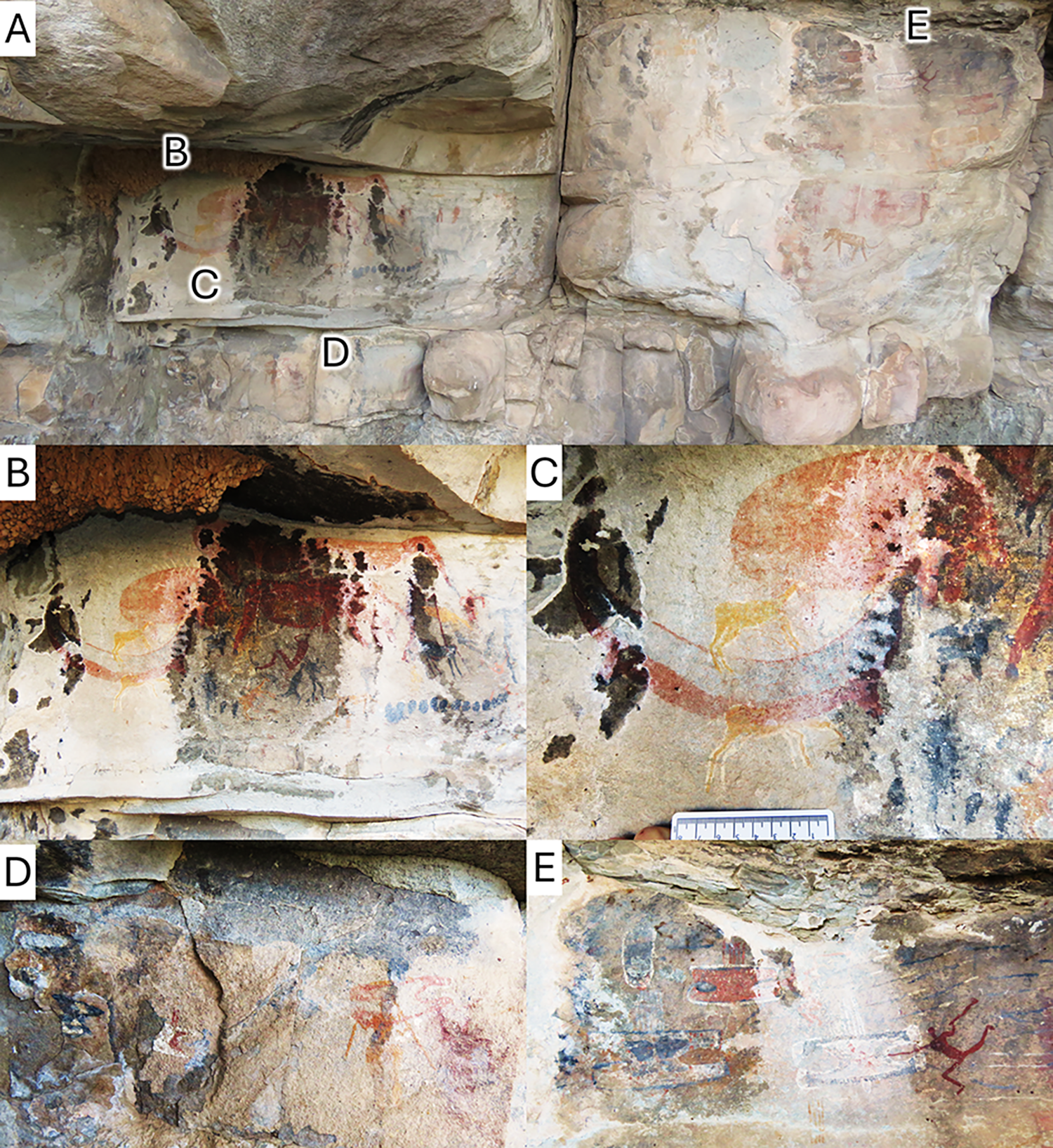Somewhere in the Koesberg Mountains of South Africa, located deep in the arid Karoo region north-east of Cape Town, there’s an exquisite cave painting of a curious creature. The creature, known as the “Horned Serpent,” bears no resemblance to any animal that lives in the region today; if anything, the creature’s distinctive downturned tusks call to mind a walrus, but the South African desert is a long, long way from the Arctic regions that walruses call home.
The Horned Serpent does, however, bear a striking resemblance to an animal that once did call the Karoo home–a dicynodont, a prehistoric creature that inhabited the region some 200 million years ago. A new paper published September 18 in PLOS One argues that the painting, which dates to between 1821 and 1835 and was created by the now-extinct /Xan-speaking San people of the region, does indeed depict a dicynodont–and that it’s based on the plentiful dicynodont fossils that can be found in the region.
Western scientists didn’t characterize dicynodonts until 1845, at least a decade after the Horned Serpent was painted. Julien Benoit, the paper’s author, explains to Popular Science that the painting is thus doubly significant: “First for the history of science, as [it suggests] the San would have found dicynodonts before western scientists; and second, cultural [significance], as the San would have integrated fossils into their belief system.”

Dicynodonts were herbivorous therapsids, notable for their mixture of reptilian and mammalian features, and for their two distinctive tusks. (The name “dicynodont” comes from the Latin for “two dog tooth.”) Their heyday came during the Late Permian era, which began 260 million years ago and ended with the Permian-Triassic Extinction Event some 250 million years ago. Like for many other animals, that event spelled disaster for dicynodonts, and while some species limped on into the Triassic Era, the last of them were well and truly gone by the end of that era–some 200 million years before homo sapiens first appeared.
This means, as Benoit says, “there is no chance that the San met a living dicynodont.” However, given that fossils are relatively common in the Main Karoo Basin, where the cave is located, there is every chance that the San found dicynodont fossils and recognized them for what they were: the preserved remains of long-dead animals. Benoit says, “This is also supported by the San myth that ‘large brutes’ roamed the land a long time ago.”
Benoit concedes that skeptics might question whether the Horned Serpent is simply the product of a fertile imagination, rather than a relatively accurate depiction of an ancient creature. However, he notes that “pure imagination may be safely ruled out as the San did not paint things that were completely imaginary. Their art was based on real-life elements, mostly animals. The new contribution adds fossils into the mix.”
As far as we know, Aristotle was the first Western thinker to suggest that fossils were once living organisms, setting the idea down around 350 BCE in his treatise Meteorology. While the Horned Serpent painting is only around 200 years old, the San are one of the oldest cultures on earth, having lived in Southern Africa for at least 20,000 years. How long they may have studied the plentiful fossils strewn around their homeland is unknown.
While the San people still live in the Kalahari–they’re often referred to as “Kalahari bushmen”—that culture is not the one that created the Horned Serpent. “The San have occupied South Africa for thousands of years,” says Benoit. “But [while] the San still live in the Kalahari, they belong to the !kung culture, whereas the San of the South African Karoo belonged to the /Xam culture. The latter is completely extinct.”
The /Xam language spoken by the San of the Karoo had no written script, so as with so many other sources of Indigenous knowledge, their millennia of accumulated knowledge died with them. Benoit says, “Unfortunately, the /Xam culture was wiped out and we can only rely on archaeology and ethnographic recordings to study them. The side effect is that the more recent data is better preserved than the older ones, and as such, the further we go back in time, the more difficult it is to understand San culture.”
Nevertheless, there are tantalizing hints of the extent of palaeontological knowledge these cultures may once have possessed. One such piece of evidence is the Mokhali Cave, located in Lesotho. It houses another piece of San rock art, created around 1810, which depicts what are unmistakably dinosaurs: “We know these are dinosaurs,” explains Benoit, “because they are depicted next to the painting of a dinosaur footprint, made in an area were fossil dinosaur footprints are commonplace. The San saw the footprints were not accompanied by handprints or tail drag marks, and as such, they imagined the dinosaurs as animals without arms and a short tail, quite similar to modern birds.”
As the paper notes, “The study of African indigenous palaeontology is still fairly young, and the evidence remains accordingly sparse and debatable, especially given the scarcity of written accounts.” Benoit says that he hopes this will change, and that we are able to recover some of the wealth of knowledge that was lost with the destruction of cultures like the /Xam San: “I hope that in the future we would be able to trace this indigenous paleontology further back in time.”

